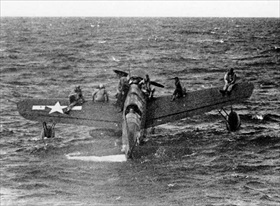U.S. SUB WAHOO MISSING ON PATROL
Honolulu, Hawaii · October 11, 1943
On this date in 1943 the USS Wahoo, a Gato-class (early World War II) submarine under Commander Dudley “Mush” Morton, was sunk in the La Pérouse (Soya) Strait, the channel that separates the northern Japanese island of Hokkaidō and the Russian Sakhalin Peninsula. Armed with ten torpedo tubes, the Wahoo was one of the most celebrated submarines of World War II, sinking at least 19 Japanese cargo and transport ships, more than any other submarine up to that time. By her fifth patrol she had set a record for sinking nearly 95,000 tons and damaging over 31,000 tons in only 25 patrol days. On her last patrol the Wahoo sank four ships for 13,000 tons. The USS Barb sank more tonnage; during seven war patrols between March 1944 and August 1945, the Barb was officially credited by the Japanese with sinking 17 vessels totaling 96,628 tons, including the aircraft carrier Unyo. The USS Tang, a Balao-class submarine (successor to the Gato-class), sank 33 ships displacing 116,454 tons in her short twelve-month career (five war patrols). Submariners accounted for less than two percent of the entire U.S. Navy in World War II, but they accounted for sixty percent of Japanese merchant marine losses and thirty percent of Japanese navy losses. Submariners faced enormous danger: more than 20 percent lost their lives aboard their vessels, and a submariner was six times more likely to die than a sailor onboard a surface ship. As a submarine skipper, the Wahoo’s “Mush” Morton was something of a daredevil. During the short ten months he commanded the sub, he lined up an impressive number of “firsts”: first to penetrate an enemy harbor and sink a ship therein, first to successfully use a down-the-throat shot, and first to wipe out an entire convoy (four ships) single-handedly. After three arduous war patrols, Morton was given the highly dangerous assignment of penetrating the Sea of Japan, the body of water sandwiched between the Japanese home islands and the Asian mainland. The loss of Morton and 80 officers and enlisted men aboard the Wahoo profoundly shocked the submarine force. All further forays into the inland sea ceased, and it was not breached again until June 1945.
[amazon_carousel widget_type=”ASINList” width=”600″ height=”200″ title=”Recommended Reading” market_place=”US” shuffle_products=”False” show_border=”False” asin=”0891415734,0451238109,047119705X,0743487990,089141889X,155750217X,0252066707,1439176841,1933177071,1557505055″ /]
U.S. Submarines Wahoo and Tang, 1941–1944
 |  |
Left: Morton (left) speaks with his executive officer, Richard O’Kane, on the bridge of the Wahoo days after torpedoing the Japanese troop transport Buyo Maru, north of New Guinea, on January 26, 1943, on the sub’s third patrol. O’Kane would later assume command of the USS Tang.
![]()
Left: A broom on the Wahoo’s periscope on its return to Pearl Harbor, 1943. The broom indicated the oceans were “swept clean.” The pennant flying from the snorkel reads, “Shoot the sunza bitches.”
 |  |
Left: The USS Tang off Mare Island Navy Yard, California, December 1943. The Tang received four battle stars and two Presidential Unit Citations for her wartime service. Her commanding officer, Lieutenant Commander Richard O’Kane, former executive officer of Wahoo, received the Medal of Honor for Tang’s final action. The Tang was credited with sinking 31 ships in her five patrols, totaling 231,500 tons, and damaging two for 4,200 tons. This wartime credit was unequaled among U.S. submarines.
![]()
Right: Downed U.S. airmen on a Vought OS2U Kingfisher near Truk Lagoon await rescue by the USS Tang, 1944. (The OS2U was a catapult-launched observation floatplane.) On her second war patrol, the Tang was assigned to lifeguard duty near Truk. The Tang rescued 22 downed airmen and transported them to Hawaii at the conclusion of her patrol.
Contemporary Film Describing World War II Submarine Service
![]()

 History buffs, there is good news! The Daily Chronicles of World War II is now available as an ebook for $4.99 on Amazon.com. Containing a year’s worth of dated entries from this website, the ebook brings the story of this tumultuous era to life in a compelling, authoritative, and succinct manner. Featuring inventive navigation aids, the ebook enables readers to instantly move forward or backward by month and date to different dated entries. Simple and elegant! Click
History buffs, there is good news! The Daily Chronicles of World War II is now available as an ebook for $4.99 on Amazon.com. Containing a year’s worth of dated entries from this website, the ebook brings the story of this tumultuous era to life in a compelling, authoritative, and succinct manner. Featuring inventive navigation aids, the ebook enables readers to instantly move forward or backward by month and date to different dated entries. Simple and elegant! Click 











